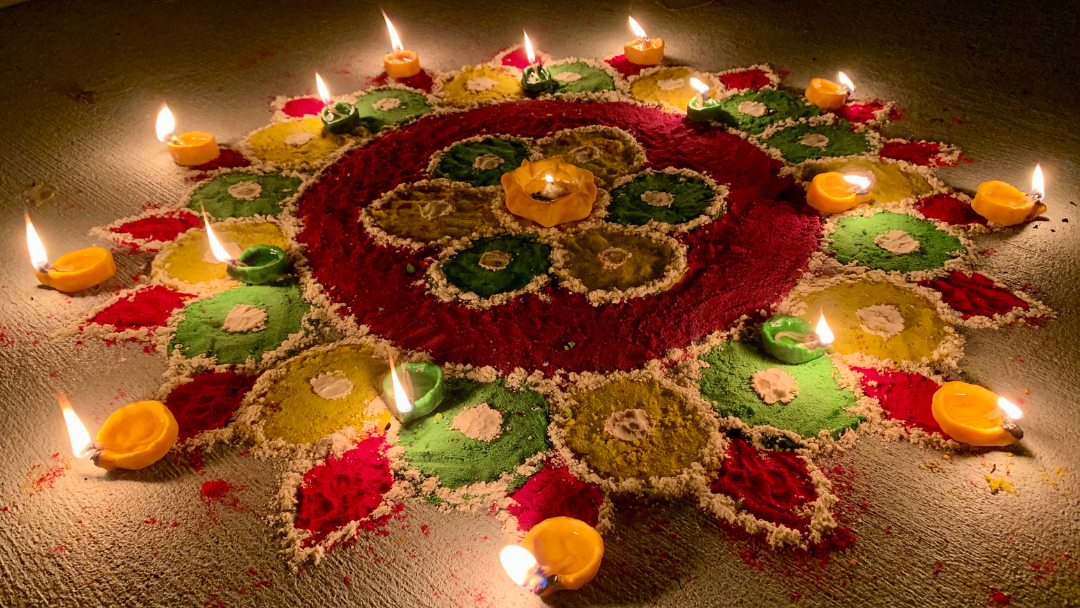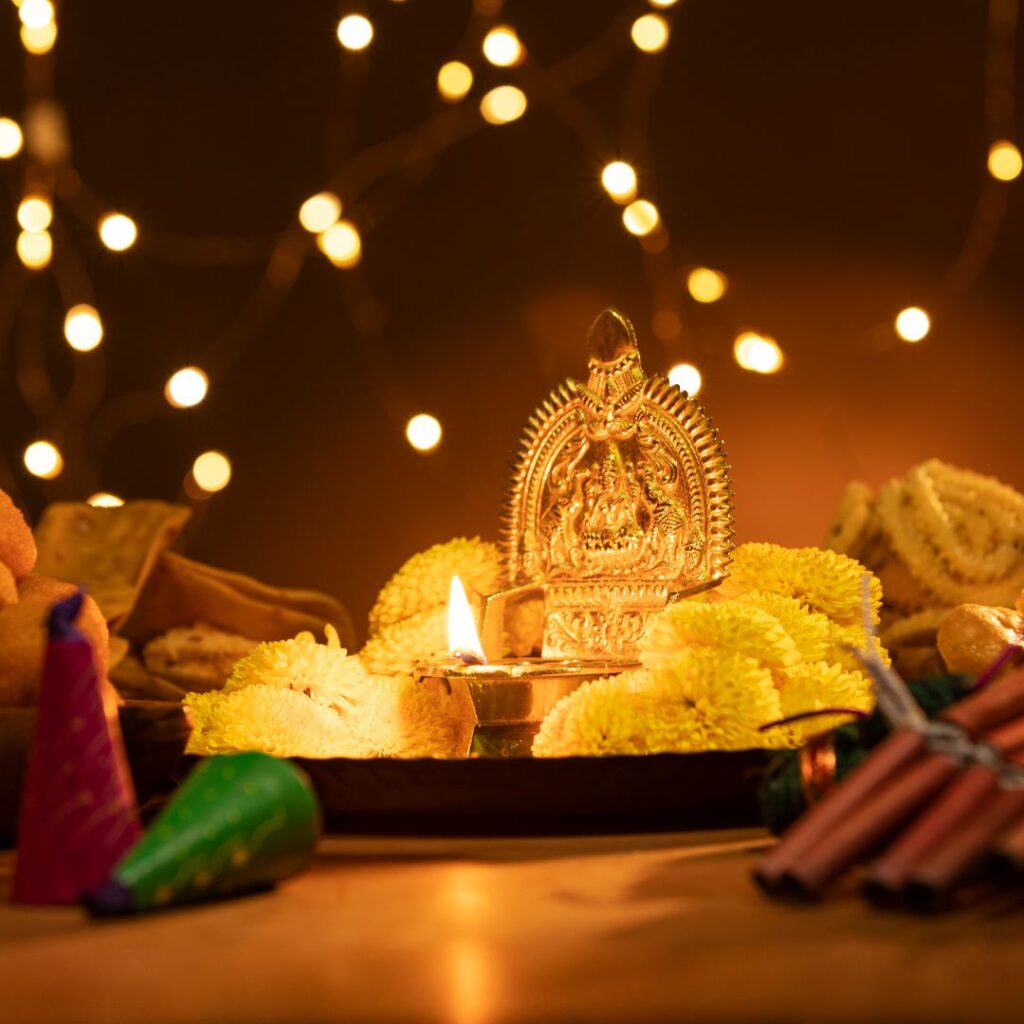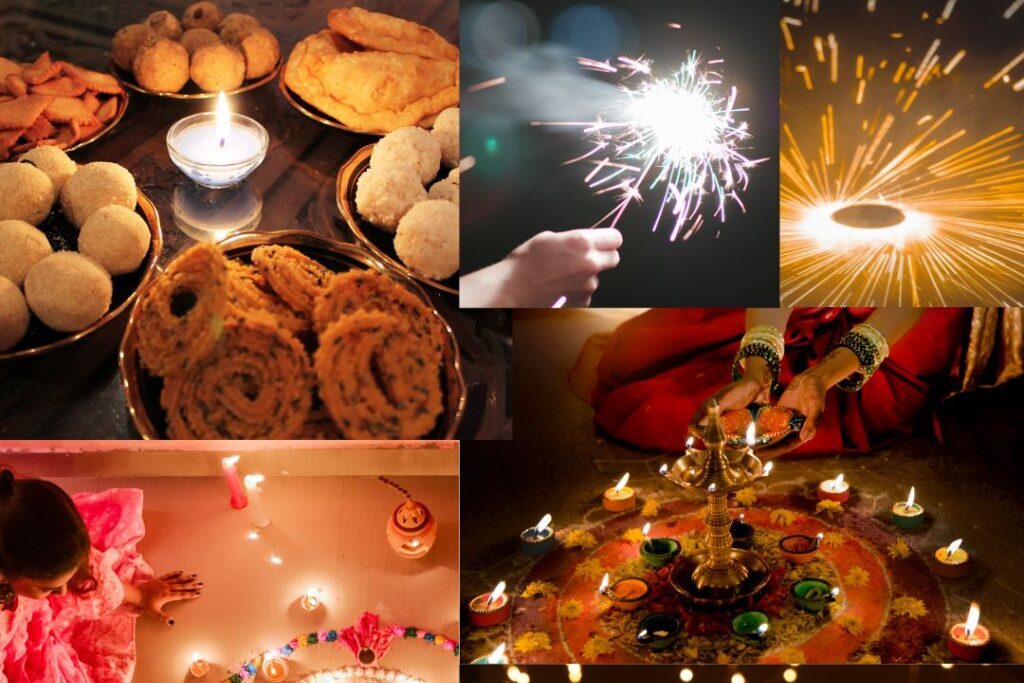As we delve into the intricate details of Diwali’s festivities and its underlying spiritual connotations, we’ll illuminate this enchanting celebration with an array of 100+ words for GRE, TOEFL and IELTS that aptly encapsulate its essence.
***(Anticipate the contextual meaning as you read through the blog. Later, click here to revise the words and their meanings.)
Diwali, the festival of lights, is a resplendent celebration that transcends boundaries and embraces the rich tapestry of Indian culture. With a history steeped in tradition and mythology, Diwali is a quintessential festival celebrated by millions across the globe. The word “Diwali” itself holds profound significance, derived from the Sanskrit words “deepa” (lamp) and “avali” (row), symbolizing the triumph of light over darkness.
Euphoric Preparations
The Diwali season commences weeks in advance as households embark on a flurry of preparations. Streets and marketplaces burgeon with an assortment of decorations, a melange of colors, and an array of aromatic delicacies. Families engage in meticulous cleaning and decorating, a ritual, known as “shringar,” to embellish their homes with vibrant rangoli patterns, marigold garlands, and shimmering lanterns.
The Significance of Each of the Five Days:
The five-day revelry commences with Dhanteras, marking the inauguration of the festivities. On this day, devout reverence is extended to Lord Dhanvantari, the revered deity associated with medicine and Ayurveda. It is also regarded as propitious to invest in gold and silver during Dhanteras, believed to usher in auspiciousness and affluence.
Diwali’s significance is grounded in a plethora of mythological narratives and enigmatic legends. The most renowned legend is the return of Lord Rama to Ayodhya following his victory over the demon king Ravana. This story highlights themes of valor, righteousness, and the ultimate triumph of good over evil. Naraka Chaturdashi, the second day, is a commemoration of Lord Krishna’s subdual of the formidable demon Narakasura. People rise at dawn to perform ablutions, signifying personal purification. Subsequently, they illuminate their residences and workplaces with the radiance of oil lamps and candles.
The third day, the central Diwali day or Lakshmi Puja, is dedicated to venerating Goddess Lakshmi, the divine patroness of wealth and prosperity. Families unite in special prayers and pujas, imploring blessings for an opulent forthcoming year. Abodes are bejeweled with oil lamps, resplendent rangoli motifs, and fragrant blossoms. As evening descends, a symphony of firecrackers reverberates, rejoicing in the supremacy of righteousness over malevolence.
The fourth day, known as Govardhan Puja or Padwa, is a day of reverence for Lord Krishna, who upraised the Govardhan Hill to shield the villagers from the wrath of Lord Indra. People also engage in the exchange of gifts and sweets, visiting their kith and kin to cement bonds of camaraderie.
The concluding day of Diwali, Bhai Dooj or Yama Dwitiya, celebrates the fraternal and sororal connection. Sisters craft delectable delicacies for their brothers, embellishing their foreheads with a tilak (vermilion mark). Brothers reciprocate with gifts to honor this cherished relationship.
During the five days, you will observe:
Radiant Decorations
An array of decorations, each reflecting a sense of opulence and festivity, festoon homes and public spaces. The artistic embellishments, from torans (door hangings) to intricate paper lanterns, add to the overall splendor of the festival.
Luminous Illumination
At the heart of Diwali lies the symbolic lighting of lamps, diyas, and candles. Kindling these luminous lights not only brightens the physical realm but also represents the inner illumination, with knowledge dispelling ignorance. The interplay of light and shadow casts an ethereal glow on the surroundings, signifying the victory of truth over falsehood.
Mellifluous Melodies
Diwali’s spiritual and cultural significance finds resonance in the mellifluous strains of devotional music and classical ragas. The enchanting melodies of bhajans (hymns) and classical compositions often captivate the hearts of devotees. The tabla, sitar, and harmonium lend a harmonious quality to the atmosphere, invoking a sense of transcendence.
Sumptuous Feasting
The Diwali feast is a cornucopia of flavors and aromas, offering a gastronomic experience that tantalizes the senses. Savory delights such as samosas, pakoras, and chaats are accompanied by an array of sweets, including the delectable gulab jamun, jalebi, and rasgulla. The extravagant spread mirrors the festival’s festive and indulgent nature.
Communal Merriment
Diwali is a time for communal bonding, transcending barriers of age, caste, and creed. Families and friends come together to exchange gifts and sweets, igniting a sense of camaraderie and warmth. The sense of togetherness exemplifies the festival’s universal appeal.
Transcendent Spirituality
For many, Diwali is not merely a festival but a deeply spiritual journey. The Sanskrit concept of “Atman” (the individual soul) and “Brahman” (the universal soul) comes into focus, inspiring introspection and the search for the divine within. It prompts contemplation of the transient nature of life and the pursuit of eternal knowledge. Praying and seeking blessings from deities invokes a sense of humility, demonstrating that even the most erudite minds have much to learn.
Exuberant Fireworks
The night of Diwali is marked by the resounding burst of fireworks that light up the sky. The sky becomes an effulgent canvas adorned with a plethora of pyrotechnic displays. The jubilant explosions metaphorically represent the celebration’s exuberance as people welcome the festival with a bang.
Charitable Giving
Diwali also underscores the significance of charitable acts and compassion. Many people dedicate a portion of their earnings to charitable endeavors, following the principle of “dharma” (duty) and “seva” (service). This philanthropic element underscores the festival’s theme of giving and sharing.
Auspicious Attire
As Diwali approaches, people adorn themselves in resplendent garments that symbolize purity and renewal. Women don colorful sarees or lehengas, often embellished with intricate embroidery and ornate jewelry. Men opt for traditional kurta-pajamas or sherwanis; children are dressed in vibrant, eye-catching attire.
Artistic Articulation
Diwali provides a platform for artistic expression as people create rangoli patterns, intricate kolam designs, and ornate mehndi (henna) artwork on their hands. These artistic endeavors, characterized by their intricate beauty, evoke a sense of splendor and admiration.
Cultural Pageantry
Diwali’s diverse regional customs and traditions add to its cultural richness. For instance, in West Bengal, the festival of Kali Puja coincides with Diwali, honoring the fierce goddess Kali. The deity is carried on ornate chariots, accompanied by music and dance. These processions are a spectacle of grandeur, exemplifying the fervor and devotion of the participants. In southern India, Diwali is celebrated with the lighting of oil lamps and the exchange of gifts. These regional variations showcase the festival’s adaptability and multifaceted nature.
Diwali, with its effulgent rituals and profound symbolism, serves as a beacon of light and unity for millions worldwide. The festivities, steeped in tradition and rich cultural heritage, resonate with the essence of human life – the pursuit of knowledge, the victory of good over evil, and the celebration of togetherness. As the festival transcends linguistic and geographical barriers, it invites people to embrace the light within and radiate positivity to the world, transcending the bounds of language, culture, and ethnicity. So, let us all partake in the magnificence of Diwali, igniting our inner diyas and celebrating the enduring spirit of humanity.
Dilip Oak’s Academy wishes you all a happy, sparkling and a safe Diwali! Hope this brings you academic success and fulfillment of your dreams.
We offer comprehensive GRE coaching in Pune, both online and classroom, to support you in this crucial aspect of your academic journey. Further, our admission counseling services can guide you through the entire process from Shortlisting Universities to Visa Counseling. With our expertise, we have successfully sent 32,000 students to various prestigious American universities like MIT, Stanford, Cornell, and Carnegie Mellon. To enroll in our comprehensive services, book a free consultation or call us at 91-020-67444222.
We offer GRE, TOEFL, and IELTS coaching, GRE Self Prep and guide students with university selection, application essays, and visa counseling under our Admission Counseling Services for USA, Germany and Canada.






